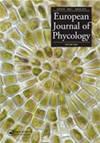First draft of an annotated genome for a lichenised strain of the green alga Diplosphaera chodatii (Prasiolales, Trebouxiophyceae)
IF 1.7
4区 生物学
Q2 MARINE & FRESHWATER BIOLOGY
引用次数: 0
Abstract
ABSTRACT Although genome sequences of lichenized fungi are increasingly becoming available, genome sequences of microalgae involved in the lichen symbiosis are still scarce. For lichenized eukaryotic algae, genome sequencing has focused mostly on Trebouxia and Asterochloris, with little genomic data available for Stichococcus-like algae, such as Diplosphaera. The genus Diplosphaera is a common component of biological soil crusts, and often occurs associated with lichens of the family Verrucariaceae. It is characterized by cylindrical to spherical cells containing a plate-like chloroplast, and more specifically by a vegetative cell division that leads to the formation of typical two- to four-celled clusters. Here, we present a draft genome sequence for the algal partner of an Australian lichen specimen of Endocarpon pusillum. The genome was sequenced with Pac Bio long read and Illumina short read technologies, and transcriptome data were generated to inform the structural annotations. This algal strain is here identified as Diplosphaera chodatii based on nuSSU and ITS data. Compared with closely related lichenized and non-lichenized algae, the genome of D. chodatii stands out for its large size (85.6 Mb) and gene content (21,261 protein-encoding regions), as well as its high rate of duplicated genes (60% of the BUSCO genes are duplicated). These results suggest that whole genome duplication or large-scale segmental duplications may have occurred in the evolutionary history of this algal species. HIGHLIGHTS Little genome data are available for lichenized algae. We generated the first genome for a lichenized Diplosphaera chodatii. Results suggest a possible whole genome duplication in this species.绿藻Diplosphaera chodatii (Prasiolales, Trebouxiophyceae)的一个地衣化菌株的基因组注释初稿
本文章由计算机程序翻译,如有差异,请以英文原文为准。
求助全文
约1分钟内获得全文
求助全文
来源期刊

European Journal of Phycology
生物-海洋与淡水生物学
CiteScore
4.80
自引率
4.20%
发文量
37
审稿时长
>12 weeks
期刊介绍:
The European Journal of Phycology is an important focus for the activities of algal researchers all over the world. The Editors-in-Chief are assisted by an international team of Associate Editors who are experts in the following fields: macroalgal ecology, microalgal ecology, physiology and biochemistry, cell biology, molecular biology, macroalgal and microalgal systematics, applied phycology and biotechnology. The European Journal of Phycology publishes papers on all aspects of algae, including cyanobacteria. Articles may be in the form of primary research papers and reviews of topical subjects.
The journal publishes high quality research and is well cited, with a consistently good Impact Factor.
 求助内容:
求助内容: 应助结果提醒方式:
应助结果提醒方式:


